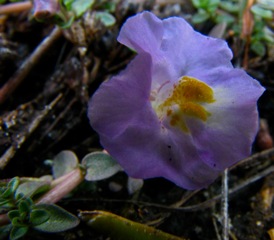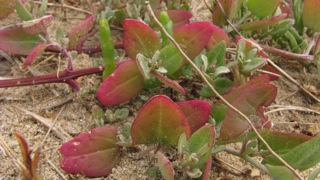At this time of year it requires some perseverance to find flowering plants.
Have a look for the small and insignificant cream/yellow flowers which are developing in the leaf axils of Coast Daisy-bush Olearia axillaris, an important coastal bush. Its lovely greyish foliage stands out amongst the other greener shrubs, and I always enjoy the wonderful aromatic smell which is released when the leaves are crushed. Also, in my quest for sensory foliage, I found that the leaves have a pleasant silky feel…so we can use three of our senses with the one plant!

Coast Daisy-bush
Also in the sand dunes, the robust Coast Sword-sedge Lepidosperma gladiatum has been bearing compact brown flower-heads for some time. The clumps of large, flat, sword-like leaves also stand out in amongst the other coastal vegetation.

Coast Sword-sedge
This is a good time of year to visit swampy areas near watercourses and inlets, as you never know what you may find there. As the water dries up it is exposing Creeping Monkey-flower Mimulus repens, a favourite of mine, which is a prostrate plant with delicate, mauve flowers which look a bit like butterflies among small crowded stalkless leaves.

Creeping Monkey-flower
You may also find Annual Celery Apium annum, a quite inconspicuous plant sprawling around and over other plants. This has clusters of tiny, white flowers and long narrow leaves. I find that feeling the stiff, ridged stems is a useful aid to identification.

Annual Celery
The low growing plant Glaucus Goosefoot Chenopodium glaucum is displaying its autumn colours as the normally green arrowhead shaped leaves change to pink, and sometimes bright red. I have recently discovered that many plants I thought were this plant are actually a relative, and a bad weed, called Fat-hen Chenopodium album…so be aware! The most obvious differences are the leaves of Glaucus Goosefoot, which are more fleshy than the leaves of Fat-Hen. Also the weed is much more robust, higher and spreading …a familiar story!

Glaucus Goosefoot
Another plant developing autumn coloration is Beaded Glasswort Sarcocornia quinqueflora, which can be seen forming extensive carpets in our estuaries. The tops of the leafless, bead-like succulent stems may have a reddish tinge due to their concentration of saline water. The stems will eventually drop and relieve the plant of its salty burden.

Bearded Glasswort
Autumn is time for the development of seeds and my current favourite is Blackwood Acacia melanoxylon. The long brown pods are twisted into wonderful contorted shapes, with an occasional pale orange seed with a black centre still lingering within the seedpods.

Blackwood
Last month I wrote about Downy Dodder-laurel Cassytha pubescens. However it was actually Slender Dodder-laurel Cassytha glabella, a similar plant, but with very fine stems and not hairy. Also, unlike the Downy Dodder-laurel, it does not appear to unduly harm the host plant.

Slender Dodder-laurel
Enjoy your autumn walks and be sure to take Flowers of Anglesea and Aireys Inlet as it can be a vital aid to plant identification.
Ellilnor Campbell